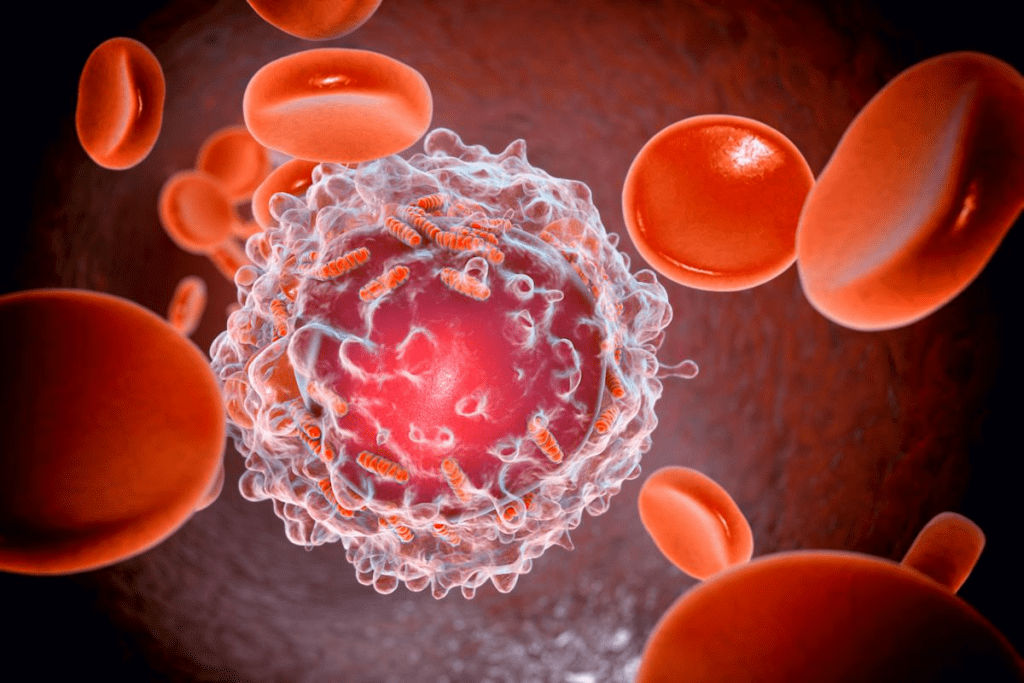Last Updated on November 13, 2025 by
Childhood leukemia is a complex condition that begins when genetic mutations occur in blood-forming stem cells in the bone marrow. These mutations cause abnormal white blood cells to grow uncontrollably, leading to what causes leukemia

Understanding the origins of childhood leukemia is key to better treatments and outcomes. Leukemia begins in the bone marrow. Genetic mutations there lead to the creation of abnormal white blood cells.
Exploring the causes of leukemia shows us how important early detection and treatment are. They are vital for better survival rates.
Understanding childhood leukemia is key to finding better treatments. It’s a cancer that affects the blood and bone marrow. It happens when abnormal white blood cells grow too much.
This disrupts how blood cells are made. It leads to many health problems.
Childhood leukemia is divided into types based on the cells affected and how fast it grows. The most common is Acute Lymphoblastic Leukemia (ALL), making up about 80% of cases. Other types include Acute Myeloid Leukemia (AML) and Chronic Leukemia, but Chronic Leukemia is rare in kids.
“Leukemia is the most common cancer in children, affecting about 4,000 kids each year in the U.S.,” says a recent study. This shows how important it is to know about this disease. One in three kids with cancer has leukemia, making research and awareness critical.
The number of kids getting leukemia varies worldwide. Kids under 15 had 2.92 cases per 100,000 in 2021. The highest rates were in kids under 1 year. This highlights the need for more research into leukemia’s causes.
Knowing what causes leukemia is vital for prevention and better treatments. While we’re not sure yet, it seems both genes and environment play a part.
As we learn more about childhood leukemia, we see how important it is to understand it well. Knowing its definition, types, and how common it is helps us improve treatments and outcomes for kids.
To understand leukemia, we must first learn about blood cell production. Blood cells are made in the bone marrow through hematopoiesis. This complex process involves many cell types working together to create the blood cells our bodies need.
Hematopoiesis is how the bone marrow makes blood cells, like red and white blood cells, and platelets. It’s key to keeping our blood cell count right. The bone marrow always makes blood cells to keep our bodies healthy. This process is tightly controlled, balancing cell creation and death.
“The regulation of hematopoiesis is a complex interplay of various factors, including growth factors, cytokines, and transcription factors,” as noted in medical literature. Knowing this helps us see how problems can cause leukemia.
The bone marrow makes most of our blood cells. In kids, it works extra hard to support growth and development. The bone marrow’s role in making blood cells is critical for a child’s health. Any problem here can cause serious issues, like leukemia.
The bone marrow creates red blood cells for oxygen transport, white blood cells for fighting infections, and platelets for clotting. Knowing how it works normally helps us understand leukemia.

In summary, blood cell development is a complex, tightly controlled process. Problems in this process can cause blood disorders, like leukemia. By understanding how blood cells are made and regulated, we can better grasp leukemia’s causes and treatments.
It’s important to know what causes leukemia in kids to help them get better. Leukemia happens when blood cells grow out of control because of genetic changes. These changes make the cells not work properly.
Most of the time, leukemia isn’t passed down from parents. But if a sibling has it, the risk is slightly higher. We’ll look into how genetic changes, random mutations, and possible triggers play a part.
Genetic changes in blood cells are a main reason for leukemia in kids. These changes mess with how cells grow and divide. This leads to cancerous cells forming.
Random mutations during cell division also play a role. These can happen by chance or because of things in the environment. When these mutations hit important genes, they can cause cells to grow too much and lead to leukemia.
What exactly starts leukemia isn’t fully known. But it’s thought that both genes and the environment play a part. Knowing this helps us find ways to prevent and treat it.
Leukemia is a complex disease with many causes. We need more research to understand how genetics, random mutations, and the environment work together.
It’s important to know if leukemia is genetic or hereditary. This helps us understand risk factors and how to prevent itthemChildhood leukemia happens when genes mutate, causing abnormal white blood cells to grow uncontrollably. We’ll look at the difference between genetic and inherited factors, the patterns in childhood leukemia, and how DNA damage leads to leukemia.
Genetic and inherited factors in leukemia are different. Genetic factors are DNA mutations that can cause leukemia. These can happen on their own or because of environmental factors. Inherited factors mean the risk is passed down from parents to children.
Children with certain genetic conditions, like Down syndrome, are more likely to get leukemia, a pediatric oncologist says,
“The presence of certain genetic syndromes can significantly increase the risk of leukemia in children, highlighting the importance of genetic screening and monitoring.”
Research shows that there might be a hereditary link in childhood leukemia. Studies found that siblings of children with leukemia are at higher risk. But the risk is not very high.
A study in the Journal of Clinical Oncology found that “the risk of leukemia in siblings of affected children is significantly higher than in the general population, but the overall risk is small.” This shows that while there might be a genetic link, it’s not the only factor.
DNA damage is key to leukemia development. Mutations can happen due to many reasons, like environmental factors, DNA copying errors, or viruses. These mutations cause abnormal white blood cells to grow uncontrollably.
Understanding DNA damage in leukemia helps in finding new treatments and prevention methods. As research advances, we’re getting closer to better treatments for children with leukemia.
It’s important to know what increases the chance of leukemia in kids. We’ll look at how some conditions and exposures can raise this risk.
Children with Down syndrome face a higher risk of leukemia. This includes acute lymphoblastic leukemia (ALL) and acute myeloid leukemia (AML). Their genetic condition makes them more likely to get leukemia. The risk is much higher in kids with Down syndrome than in others.
Some environmental factors can raise the risk of leukemia in kids. For example, ionizing radiation from nuclear accidents or some medical treatments can increase this risk. Also, some chemicals and pesticides might play a part in leukemia development.
Genetic conditions other than Down syndrome can also raise leukemia risk. Kids who had chemotherapy or radiation for other cancers are at higher risk. Some genetic syndromes and inherited conditions can also make kids more likely to get leukemia.
Knowing these risk factors helps us spot kids at higher risk. We can then take steps to watch them closely and prevent leukemia. Early action is key to helping kids with leukemia.
Learning about acute lymphoblastic leukemia is key to finding better treatments. It’s a big part of pediatric cancers. Most kids get diagnosed with ALL between 2 and 4 years old.
ALL makes up about 15“25% of pediatric cancers. This makes it a big worry for doctors and families. We’ll look into why it’s so common in kids.
Genetic and environmental factors cause ALL in children. Studies show that genetic changes in blood cells are a big part of it.
ALL is also found in adults, but it’s different in kids. Kids with ALL usually do better and have higher cure rates than adults.
We’ll talk about what makes ALL in kids special. This includes the genetic changes that happen early on. These are different from those in adults.
ALL develops from a mix of genetic and environmental factors. We’ll explain how a genetic change in blood cells leads to the disease.
Knowing how ALL starts is important. It helps us find new ways to treat it and improve outcomes.
Childhood leukemia shows different patterns around the world. It’s clear that where you live and your economic status affect your chances of getting leukemia. Access to healthcare also plays a big role.
Leukemia is becoming more common in low and middle-income countries. These places often struggle to diagnose and treat leukemia because of limited resources. This makes it harder for kids to survive.
Recent data shows a big increase in leukemia cases. But in rich countries, death rates have dropped a lot thanks to better treatments. This shows a big gap in healthcare quality.
Children with leukemia face different treatment options based on where they live. Rich countries have better treatments, like new medicines and stem cell transplants. But, poor countries often can’t offer these advanced treatments.
These differences lead to different survival rates in different parts of the world.
Death rates for childhood leukemia are much higher in poor countries. Rich countries have made big strides in treating leukemia early and effectively. But, poor countries face many challenges that make it harder to save lives.
We need to work together to fix these problems. Improving healthcare worldwide is key to saving more children with leukemia.
“The disparity in childhood leukemia survival rates between high-income and low-income countries is a stark reminder of the need for global cooperation in healthcare.”
Pediatric Oncologist
Understanding childhood leukemia has led to big steps in treatment. Leukemia is a cancer that affects the body’s blood-making cells. It often comes from genetic changes in these cells.
Studies show that leukemia is caused by both genes and the environment. This knowledge helps doctors find better ways to treat it.
Thanks to new treatments and standard plans, kids with leukemia are doing better. Our team is dedicated to top-notch care for all patients, including those from abroad. For more on leukemia, from other leukemia resources. More research will help us fight this disease even better.
Childhood leukemia is a cancer that affects the blood and bone marrow. It happens when the body makes too many bad white blood cells.
Leukemia can have a genetic link, but it’s not always passed down. It starts with genetic changes in blood cells. Some genetic conditions can raise the risk.
Leukemia in kids is caused by many things. It includes genetic changes, random cell mutations, and possible environmental factors.
Kids with Down syndrome are more likely to get acute lymphoblastic leukemia. This is because of the genetic links to the condition.
Risk factors include genetic conditions like Down syndrome. Also, environmental exposures and pre-existing genetic conditions can lead to abnormal cell growth.
Acute lymphoblastic leukemia is the most common leukemia in kids. It’s when the bone marrow makes too many bad lymphoblasts.
Leukemia starts in the bone marrow. Genetic changes cause the production of bad white blood cells. This disrupts normal blood cell development.
Yes, there are patterns in childhood leukemia. Incidence rates and treatment outcomes vary by region and country.
DNA damage can lead to leukemia. It causes genetic mutations in blood cells. This results in abnormal cell growth.
Some environmental exposures might trigger leukemia. But the exact link between environmental factors and leukemia is being studied.
Subscribe to our e-newsletter to stay informed about the latest innovations in the world of health and exclusive offers!